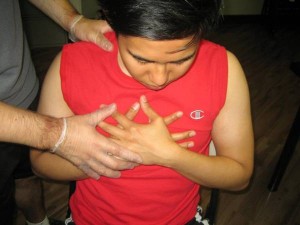Major chest trauma may occur singly or in combination with multiple other injuries such as those sustained in a motor vehicular crash. Chest trauma is better classified as either blunt or penetrating. Blunt chest trauma results from sudden compression or positive pressure inflicted to the chest wall whereas penetrating chest trauma occurs when a foreign object pierces the thoracic cavity.
Blunt thoracic chest trauma and injuries are responsible for approximately 8% of trauma related admissions in North America alone based on the cumulative report by hospitals collated by the United State’s Federal Health Department in 2009. It is often very difficult to identify the extent of the damage because the manifesting signs and symptoms are predominantly generalized and vague. In addition, patients often does not seek immediate medical attention which may further aggravate and complicate the existing problem.
Pathophysiology of a chest trauma
The most common cause of blunt chest trauma is motor vehicle crashes, especially those sustained from the impact to the steering wheel, seat belt, falls, bicycle crashes (trauma from impact to the handlebars). The mechanism of blunt chest trauma including acceleration (the movement of a fast moving object hitting the chest wall or the victim being violently thrown into high velocity such as a motor vehicle crash, shearing (stretching forces to regions of the chest which causes ruptures or tears and compression (direct blow to the thoracic region such as a crush injury). Injuries to the chest are often very life-threatening in nature and result in one or more of the following conditions:
- Hypovolemia from massive blood loss from the major blood vessels.
- Hypoxemia from disruption of the airway; injury to the lung cavity, rib cage and underlying respiratory musculature.
- Cardiac failure resulting from cardiac tamponade, cardiac contusion or increased intra-thoracic pressure.
Assessment findings of chest trauma
Initial assessment of thoracic injuries or chest trauma includes assessment for airway obstruction, pneumothorax, flail chest and cardiac tamponade. The aforementioned injuries are extremely life-threatening that requires immediate medical intervention. Secondary assessment would normally include evaluation for injuries that would generally affect ventilation and oxygenation as well as the integrity and patency of the airway and all other underlying tissues of the respiratory system. The physical examination includes inspection of the airway, neck veins, thorax, and subjective reports for difficulty in breathing. The specifics include assessing the rate and depth of breathing for any abnormalities, such as cyanosis, use of accessory muscles, asymmetric chest movement, breath sounds as well as any visible signs of open wounds or impaled objects to the chest.
Medical management of chest trauma

The goals of treatment are generally geared towards the evaluation of the individual’s condition and upon the presenting situation initiate aggressive resuscitation. An airway is immediately established with oxygen and ventilatory support. Reestablishing fluid volume and negative intrapleural pressure and drainage are very vital for the survival of the individual. The majority of the treatment efforts will be mostly to effectively control active bleeding. Depending on the success of the efforts to control bleeding , the individual who sustained a traumatic chest trauma may be taken immediately to the operating room for further invasive life-saving measures.
